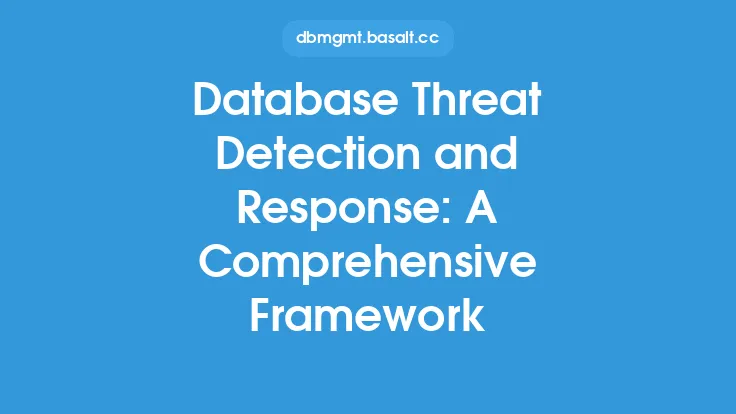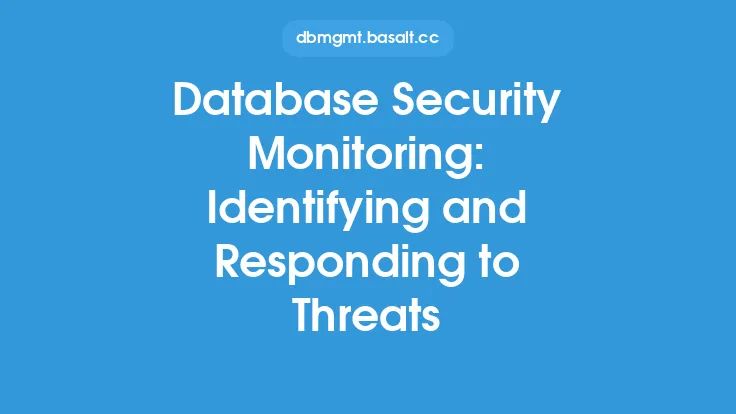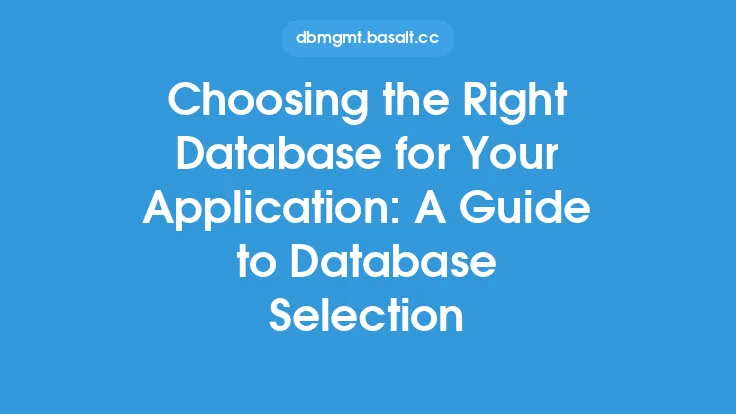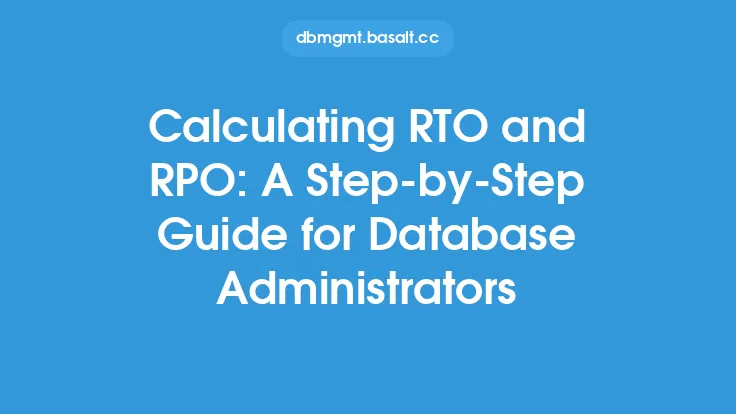Database security is a critical aspect of any organization's overall security posture, as databases often contain sensitive and valuable data. One of the key components of database security is understanding and mitigating database threats. Database threats can come in many forms, including unauthorized access, data breaches, and malicious activity. In this article, we will delve into the world of database threats, exploring the different types of threats, how to detect them, and how to respond to them.
Types of Database Threats
There are several types of database threats that organizations should be aware of. These include:
- SQL Injection: This type of threat occurs when an attacker injects malicious SQL code into a database in order to extract or modify sensitive data. SQL injection attacks can be particularly devastating, as they can allow attackers to gain access to sensitive data, modify database structures, and even take control of the database.
- Privilege Escalation: This type of threat occurs when an attacker gains elevated privileges within a database, allowing them to perform actions that they would not normally be able to perform. Privilege escalation attacks can be particularly dangerous, as they can allow attackers to gain access to sensitive data and perform malicious actions.
- Data Tampering: This type of threat occurs when an attacker modifies or deletes data within a database. Data tampering attacks can be particularly damaging, as they can compromise the integrity of the data and cause significant financial and reputational damage.
- Denial of Service (DoS): This type of threat occurs when an attacker attempts to make a database unavailable by overwhelming it with traffic. DoS attacks can be particularly disruptive, as they can prevent legitimate users from accessing the database and cause significant downtime.
Detection of Database Threats
Detecting database threats is a critical component of database security. There are several ways to detect database threats, including:
- Monitoring Database Logs: Database logs can provide valuable insights into database activity, including login attempts, queries, and errors. By monitoring database logs, organizations can identify potential security threats and take action to mitigate them.
- Using Intrusion Detection Systems (IDS): IDS systems can monitor database traffic and identify potential security threats in real-time. IDS systems can be particularly effective at detecting SQL injection and privilege escalation attacks.
- Conducting Regular Security Audits: Regular security audits can help organizations identify potential security vulnerabilities and take action to mitigate them. Security audits can include vulnerability scans, penetration testing, and configuration reviews.
- Implementing Anomaly Detection: Anomaly detection systems can monitor database activity and identify patterns of behavior that are outside the norm. Anomaly detection systems can be particularly effective at detecting data tampering and DoS attacks.
Response to Database Threats
Responding to database threats is a critical component of database security. There are several steps that organizations can take to respond to database threats, including:
- Containment: The first step in responding to a database threat is to contain the threat and prevent it from spreading. This can include isolating the affected database, blocking traffic from the attacker's IP address, and disabling affected user accounts.
- Eradication: Once the threat has been contained, the next step is to eradicate the threat and remove any malicious code or backdoors. This can include removing malware, deleting malicious files, and restoring the database from backups.
- Recovery: After the threat has been eradicated, the next step is to recover the database and restore it to a known good state. This can include restoring the database from backups, rebuilding database indexes, and reapplying security patches.
- Post-Incident Activities: After the threat has been contained, eradicated, and recovered, the final step is to conduct post-incident activities. This can include conducting a root cause analysis, updating security policies and procedures, and providing training to database administrators.
Database Threat Detection Tools
There are several database threat detection tools that organizations can use to detect and respond to database threats. These include:
- Database Activity Monitoring (DAM) Tools: DAM tools can monitor database activity and identify potential security threats in real-time. DAM tools can be particularly effective at detecting SQL injection and privilege escalation attacks.
- Intrusion Detection Systems (IDS): IDS systems can monitor database traffic and identify potential security threats in real-time. IDS systems can be particularly effective at detecting SQL injection and privilege escalation attacks.
- Security Information and Event Management (SIEM) Systems: SIEM systems can collect and analyze log data from multiple sources, including databases, network devices, and operating systems. SIEM systems can be particularly effective at detecting data tampering and DoS attacks.
- Vulnerability Scanning Tools: Vulnerability scanning tools can identify potential security vulnerabilities in databases and provide recommendations for remediation. Vulnerability scanning tools can be particularly effective at detecting configuration vulnerabilities and missing security patches.
Best Practices for Database Threat Detection and Response
There are several best practices that organizations can follow to detect and respond to database threats. These include:
- Implementing a Defense-in-Depth Strategy: A defense-in-depth strategy involves implementing multiple layers of security controls to protect databases from threats. This can include firewalls, intrusion detection systems, and encryption.
- Conducting Regular Security Audits: Regular security audits can help organizations identify potential security vulnerabilities and take action to mitigate them. Security audits can include vulnerability scans, penetration testing, and configuration reviews.
- Providing Training to Database Administrators: Providing training to database administrators can help them identify and respond to database threats. Training can include security awareness training, incident response training, and technical training on database security tools and technologies.
- Implementing Incident Response Planning: Incident response planning involves developing a plan for responding to database threats. This can include identifying roles and responsibilities, establishing communication protocols, and developing procedures for containment, eradication, and recovery.





